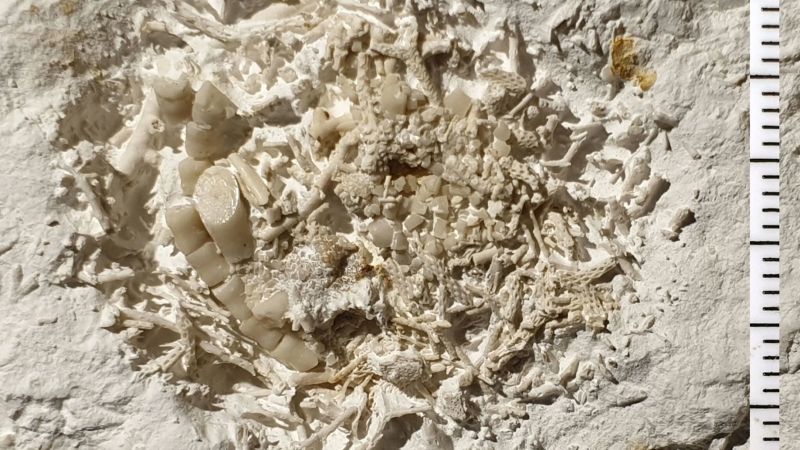In a remarkable archaeological discovery, an amateur fossil hunter in Denmark has unearthed a fascinating specimen of ancient animal vomit, which is estimated to be around 66 million years old. This astonishing find was made on the picturesque beach of Stevns Klint, an area renowned for its rich geological history. The fossil, which consists of a unique cluster of plant materials, will soon be put on display at the Geomuseum Faxe, a local museum dedicated to preserving and showcasing geological and archaeological treasures.
The amateur fossil enthusiast, Peter Bennicke, stumbled upon this extraordinary specimen when he noticed what he described as a “strange small cluster of lily pieces embedded within a piece of chalk.” His discovery highlights the thrill of fossil hunting, where even an ordinary beach can become a portal to understanding past life on Earth. Recognizing the significance of his find, Bennicke brought the specimen to the Geomuseum Faxe, where it underwent a thorough cleaning and examination.
Upon inspection, the museum enlisted the expertise of John Jagt, a specialized expert in lilies from the Netherlands. Jagt was able to determine that the cluster comprises at least two species of lily, likely representing the indigestible remains of the plants that were regurgitated by an ancient animal. This intriguing mixture is part of a broader classification known as “regurgitalite,” a term used for fossilized digestive material that provides crucial insight into the dietary habits of prehistoric organisms.
In the museum’s official statement, Jagt emphasized the importance of such finds in reconstructing ancient ecosystems, stating that they provide invaluable information regarding the nature of food webs and predator-prey relationships from that era. Fossils like Bennicke’s offer a window into the past, revealing the complex interactions between flora and fauna in the Cretaceous period, a time characterized by the dominance of dinosaurs and an array of marine life.
Jesper Milàn, a curator at the Geomuseum Faxe, expressed his enthusiasm about the fossil, dubbing it “truly an extraordinary find.” He elaborated on the significance of lilies as a food source, noting that while these plants are not particularly nutritious—composed mainly of calcium plates with minimal soft tissue—they hold vital clues about the ecosystems of the past. Milàn theorized that the animal responsible for this regurgitated material was likely a fish that inhabited the ancient seabed of the Cretaceous Sea, showcasing the diverse diets that these creatures had to adapt to during their existence.
This discovery not only sheds light on the feeding habits of marine life during the Cretaceous period but also enhances our understanding of the food chains that existed in ancient seas. As Milàn stated, this find offers valuable new knowledge about the relationships between various species, specifically relating to how predators interacted with their prey. Such a complex interplay is key to reconstructing the ecological dynamics of prehistoric environments, allowing scientists to piece together life as it was millions of years ago.
In conclusion, Peter Bennicke’s serendipitous discovery exemplifies the excitement and significance of amateur fossil hunting. With the help of professionals at Geomuseum Faxe, this unique regurgitalite will contribute to our understanding of ancient ecosystems, providing a glimpse into the diets and interactions of creatures that roamed the Earth long before humans. As the fossil prepares for public display, it stands as a testimony to the enduring mysteries of our planet’s geological past, igniting curiosity about the life forms that once thrived in its ancient waters.











